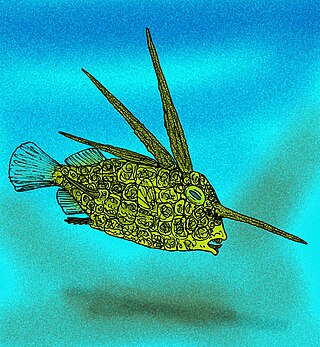
Eospinus daniltshenkoi is an extinct tetraodontid bony fish from the Eocene. Its fossils are from the Danata Formation lagerstatten of Ypresian Turkmenistan.

Proaracana dubia is an extinct, prehistoric aracanid boxfish that lived during the Lutetian of middle Eocene Monte Bolca.

Spinacanthus cuneiformis is an extinct prehistoric tetraodontid bony fish that lived from the Lutetian epoch of Eocene Monte Bolca.
Paranguilla tigrina is an extinct prehistoric eel that lived during the Lutetian epoch of the Eocene, in what is now Monte Bolca.

Bolcyrus is an extinct genus of prehistoric bony fish that lived from the early to middle Eocene.
Eosaurichthys is an extinct saurichthyid ray-finned fish that lived during the late Permian epoch in what is now China. It closely resembles its daughter genus, Saurichthys, in both form and morphology.

Eolactoria sorbinii is an extinct prehistoric boxfish that lived during the Lutetian epoch of the middle Eocene, in Monte Bolca. It had two pairs of long spines, one over each eye, and one pair beneath the anal and caudal fins, arranged very similarly to those possessed by the modern genus Lactoria, but were, in comparison, much longer. E. sorbinii had a fifth spine between the two eye-spines, arranged and looking very much like a nose.
Archaephippus is an extinct genus of prehistoric spadefish that lived from the early to middle Eocene. Several exquisitely preserved fossils have been found from the Monte Bolca lagerstatten.
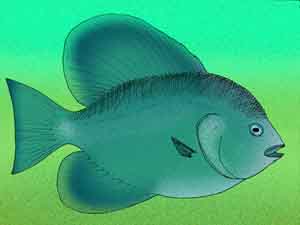
Psettopsis subarcuatus is an extinct, prehistoric moonyfish that lived during the Lutetian epoch of Monte Bolca, Italy.

Eoplatax is an extinct genus of prehistoric spadefish that lived during the Lutetian of Monte Bolca. They are closely allied to the extant genus, Platax, more commonly known as "batfish."
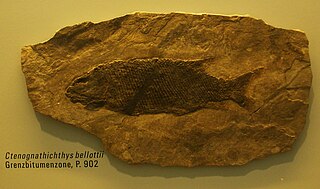
Ctenognathichthys is an extinct genus of prehistoric bony fish that lived during the early Ladinian stage of the Middle Triassic epoch. It was a small fish measuring 21 cm (8.3 in) long.
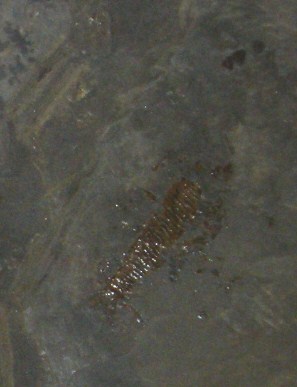
Habroichthys is an extinct genus of prehistoric bony fish that lived during the early Ladinian stage of the Middle Triassic epoch, 242 to 232 million years ago. It has been found in Austria, China, Italy, Slovenia, and Switzerland. It was a small fish measuring 26 cm (10 in) long.
Swenzia is an extinct genus of coelacanthid fish from the late Jurassic of France. It contains a single species, S. latimerae, which was originally described as Wenzia latimerae. Because the generic name Wenzia was already preoccupied by a snail, the generic name was amended to Swenzia. It is the fossil genus most closely related to the living coelacanth, Latimeria.

Bobasatrania is an extinct genus of prehistoric bony fish that survived the Permian-Triassic extinction event. Fossils of Bobasatrania were found in beds of Changhsingian to Ladinian age. It was most speciose during the Early Triassic. The genus was named after the locality Bobasatrana in northeast Madagascar, from where the type species was described.
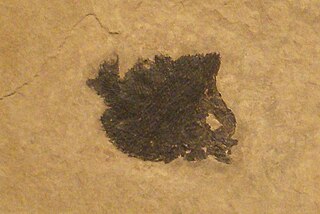
Gibbodon cenensis is an extinct pycnodontid of the family Brembodontidae. G. cenensis fossils are known from the Late Triassic strata of Cene, Italy.
Psilichthys is an extinct genus of prehistoric bony fish from the Lower Cretaceous epoch of what is now Victoria, Australia. It has previously been referred to the family Birgeriidae; however it was removed from this family due to differences with Birgeria.
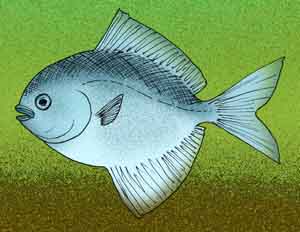
Pasaichthys pleuronectiformis is an extinct, prehistoric moonyfish that lived during the Lutetian epoch of Monte Bolca, Italy. The average length of its fossils is about 6 centimeters. In life, it would probably resemble its living relatives of the genus Monodactylus.

Protobalistum imperiale is an extinct prehistoric tetraodontid bony fish that lived from the Lutetian epoch of Eocene Monte Bolca.

Spinacanthidae is an extinct prehistoric family of tetraodontid bony fish that lived from the Lutetian epoch of Eocene Monte Bolca.

Ohmdenia is an extinct genus of prehistoric bony fish that lived from the Toarcian stage of the Early Jurassic epoch. Ohmdenia was first described in 1953 by Bernhard Hauff, based on a fossil found in the well-known Posidonia Shale in Holzmaden, Germany. For a long time this animal has been considered a close relative of Birgeria, a great predator typical of the Triassic period with an uncertain systematic position. Further studies have shown similarities with the Pachycormiformes, a group considered close to the origin of teleosts and also including giant forms and planktives. Some studies have erroneously indicated Ohmdenia as a synonym of Saurostomus, other studies have instead placed Ohmdenia as an important evolutionary passage between the basal pachicormiforms and the more derived planktivore pachicormiformes.













